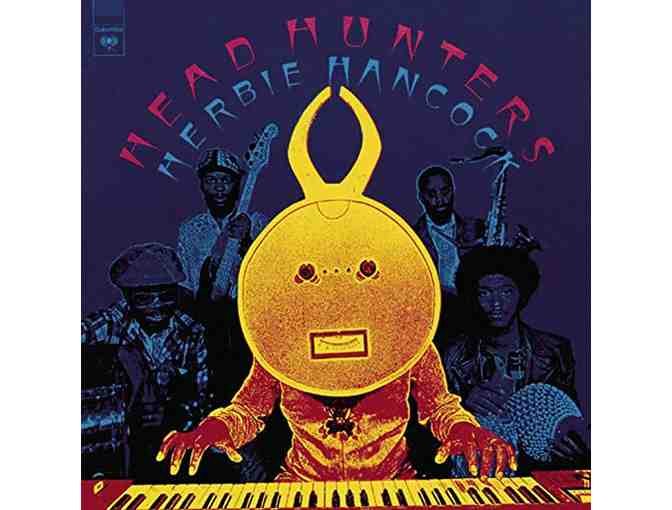Collectibles
Head Hunters Album Cover in frame (12 X 12") - No LP included
- Item Number
- 231
- Estimated Value
- 25 USD
- Sold
- 13 USD to starman
- Number of Bids
- 2 - Bid History
Item Description
Head Hunters is the twelfth studio album by the American pianist and composer Herbie Hancock, released October 13, 1973, on Columbia Records. Recording sessions for the album took place during evening at Wally Heider Studios and Different Fur Trading Co. in San Francisco, California. Head Hunters is a key release in Hancock's career and a defining moment in the genre of jazz. In 2003, the album was ranked number 498 in the book version of Rolling Stone magazine's list of the 500 greatest albums of all time. In 2007, the Library of Congress added it to the National Recording Registry, which collects "culturally, historically or aesthetically important" sound recordings from the 20th century.
Structure and release
Head Hunters followed a series of experimental albums by Hancock's sextet: Mwandishi, Crossings, and Sextant, released between 1971 and 1973, a time when Hancock was looking for a new direction in which to take his music:
I began to feel that I had been spending so much time exploring the upper atmosphere of music and the more ethereal kind of far-out spacey stuff. Now there was this need to take some more of the earth and to feel a little more tethered; a connection to the earth. ... I was beginning to feel that we (the sextet) were playing this heavy kind of music, and I was tired of everything being heavy. I wanted to play something lighter.
— Hancock's sleeve notes: 1997 CD reissue
For the new album, Hancock assembled a new band, the Headhunters, of whom only Bennie Maupin had been a sextet member. Hancock handled all synthesizer parts himself (having previously shared these duties with Patrick Gleeson) and he decided against the use of guitar altogether, favoring instead the clavinet, one of the defining sounds on the album. The new band featured a tight rhythm and blues-oriented rhythm section composed of Paul Jackson (bass) and Harvey Mason (drums), and the album has a relaxed, funky groove that gave the album an appeal to a far wider audience. Perhaps the defining moment of the jazz-fusion movement (or perhaps even the spearhead of the Jazz-funk style of the fusion genre), the album made jazz listeners out of rhythm and blues fans, and vice versa. The album mixes funk rhythms, like the busy high hats in 16th notes on the opening track "Chameleon", with the jazz AABA form and extended soloing.
Of the four tracks on the album "Watermelon Man" was the only one not written for the album. A hit from Hancock's hard bop days, originally appearing on his first album Takin' Off, it was reworked by Hancock and Mason and has an instantly recognizable intro featuring Bill Summers blowing into a beer bottle, an imitation of the hindewho, an instrument of the Mbuti Pygmies of Northeastern Zaire. The track features heavy use of African percussion. "Sly" was dedicated to the pioneering funk musician Sly Stone, leader of Sly and the Family Stone. "Chameleon" (the opening track) is another track with an instantly recognizable intro, the introductory line played on an ARP Odyssey synth. "Vein Melter" is a slow-burner, predominantly featuring Hancock and Maupin, with Hancock mostly playing Fender Rhodes electric piano, but occasionally bringing in some heavily effected synth parts.
Heavily edited versions of "Chameleon" and "Vein Melter" were released as a 45 rpm single.
After its initial release, the album was also mixed into quadraphonic (4-channel sound) and released by Columbia in 1974 in the vinyl and 8-track tape formats. The quad mixes features audio elements not heard in the stereo version, including a 2-second keyboard melody at the beginning of "Sly" that was edited out. It was released digitally on the SACD edition for the album (Columbia/Legacy CS 65123).
Until George Benson's Breezin' (1976), it was the largest-selling jazz album of all time, and has been an inspiration not only for jazz musicians, but also to funk, soul music, jazz funk and hip hop artists.
The Headhunters band (with Mike Clark replacing Harvey Mason) worked with Hancock on a number of other albums, including Thrust (1974), Man-Child (1975), Flood (recorded live in Japan, 1975). The subsequent albums Secrets (1976) and Sunlight (1977), had widely diverging personnel. The Headhunters, with Hancock featured as a guest soloist, produced a series of funk albums, Survival of the Fittest (1975) and Straight from the Gate (1978), the first of which was produced by Hancock and included the big hit "God Make me Funky".
The image on the album cover, designed by Victor Moscoso, is based on the African kple kple mask of the Baoulé tribe from Ivory Coast. The image is also based on tape head demagnetizers used on reel-to-reel audio tape recording equipment at the time of this recording. (Wikipedia)
Item Special Note
Winner must pick up at our main studios during regular business hours, 220 S 4th Avenue, Tucson AZ 85701, or it can be mailed for $7.20.
KXCI 91.3FM Community Radio stores data...
Your support matters, so KXCI 91.3FM Community Radio would like to use your information to keep in touch about things that may matter to you. If you choose to hear from KXCI 91.3FM Community Radio, we may contact you in the future about our ongoing efforts.
Your privacy is important to us, so KXCI 91.3FM Community Radio will keep your personal data secure and KXCI 91.3FM Community Radio will not use it for marketing communications which you have not agreed to receive. At any time, you may withdraw consent by emailing Privacy@frontstream.com or by contacting our Privacy Officer. Please see our Privacy Policy found here PrivacyPolicy.

